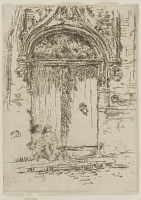Etchings Institutions search term: grolier club
The Hangman's House, Tours | ||
| Number: | 393 | |
| Date: | 1888 | |
| Medium: | etching and drypoint | |
| Size: | 135 x 99 mm | |
| Signed: | butterfly at lower left | |
| Inscribed: | no | |
| Set/Publication: | no | |
| No. of States: | 3 | |
| Known impressions: | 6 | |
| Catalogues: | K.376; M.376 | |
| Impressions taken from this plate (6) | ||
KEYWORD
TITLE
There are many variations on the title, spelling and punctuation by Whistler and others, including the following:
'House of Tristan' (1888, Whistler). 2
'The Hangman's House' (1889, Whistler). 3
'The Hangman's House (Tristan) Tours' (1889, Whistler). 4
'Tristan's House' (1889, Whistler). 5
'Hangman's House - Tristan' (1889, Whistler). 6
'Hangmans House' (1889, Whistler). 7
'Tristan L'Hermite' (1889, Whistler). 8
'Hangman's Doorway' (1897, Wunderlich's). 9
'Hangman's House, Tours' (1899, Frederick Wedmore (1844-1921)). 10
'Hangman's House, Bourges' (1900, Caxton Club). 11
'The Hangman's House, Tours' (1903/1935, possibly Rosalind Birnie Philip (1873-1958)). 12
In the 1880s the doorway shown in the etching led to what was known, mistakenly, as the House of Tristan L'Hermitte, in Tours. Tristan was a historical and legendary character, both Provost and hangman.
Several of these titles are therefore perfectly valid, except for the Caxton Club's mistake in identifying the site as Bourges.
'The Hangman's House, Tours' is the preferred title as it combines the dominant elements of these titles.
2: List, [August 1887/1888], GUW #13233.
3: Whistler to J. P. Heseltine, 20 January 1889, GUW #13037.
4: To Dowdeswell, 21 January 1889, GUW #13030.
5: To H. James, [17 February 1889], GUW #10934.
6: To E.G. Brown, 27 March 1889, GUW #13000.
7: List, 18 July 1889, GUW #13235.
8: To R. Knoedler, 20 July 1889, GUW #13080.
9: Wunderlich's to Whistler, [August 1897], GUW #07289.
10: Wedmore 1899 (cat. no. 323).
11: Chicago 1900 (cat. no. 262).
12: Envelope containing copper plate, Hunterian Art Gallery.
DESCRIPTION
13: Mansfield thought the lunette had a decorative wrought iron grating, Mansfield 1909 (cat. no. 376).
SITE
14: John Murray, A Handbook for Travellers in France, London, 1875, 13th ed., part 1, p. 219.
15: Henry James, A Little Tour in France, Boston: James R. Osgood & Co., 1885, chapter 3.
Later views of this site include an 1898 drawing of the doorway of 'Maison dit de Tristan in rue Briconnet' reproduced by Armand C. Guéritte in Le vieux Tours. Architecture - Archeologie. 17
16: Whistler to James, [17 Feb. 1889], GUW #10934; Ailsa Boyd, '"Something vibrates back": Whistler & Henry James', in E. Hermens, J. Meacock & G. Petri (eds.), CONNECTING WHISTLER, Glasgow, 2010, pp. 62-68 at www.gla.ac.uk/ media/media_182035_en.pdf.
17: Paris, 1908, pl. 35.
DISCUSSION
18: e.g. r.: Sir Piercie Shafton sings; v.: A woman with long hair; wheels [m0066].
19: James, 1885, op. cit.
